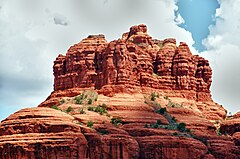| Schnebly Hill Formation | |
|---|---|
| Stratigraphic range: 286–273 Ma PreꞒ Ꞓ O S D C P T J K Pg N | |
 Bell Rock, Sedona Bell Rock, Sedona | |
| Thickness | 800 feet (240 m) to 1,000 feet (300 m) |
| Lithology | |
| Primary | Sandstone |
| Location | |
| Region | Colorado Plateau |
| Country | United States |
| Type section | |
| Named for | Sedona Schnebly |
| Location | Arizona |
| Thickness at type section | 800 feet (240 m) to 1,000 feet (300 m) |
The Schnebly Hill Formation is a section of red bed deposits found at the Colorado Plateau, near Sedona, Arizona. It is a dark red sandstone, from 800 feet (240 m) to 1,000 feet (300 m) thick. It lies between Coconino Sandstone and the older Hermit Formation. It is near the Supai Group.
The source of the name "Schnebly" is Sedona Schnebly, after whom the city of Sedona, Arizona, was named.
Geology
The formation traces to the Permian Age.
The formation is the most prominent layer of the red rocks of the Sedona area due the presence of hematite – iron-oxide (rust) – giving the sandstone a red color. The Schnebly Hill Sandstone formation comprises three sections:
- the Bell Rock member,
- the Fort Apache member, and
- the Sycamore Pass member.
See also
Sedona-area rocks
- Bell Rock
- Capitol Butte
- Cathedral Rock
- Courthouse Butte
- Red Rock State Park
- Slide Rock State Park
- Two Nuns
Local geology
Local interest
- Cottonwood, Arizona
- Honanki
- Jerome, Arizona
- Jerome State Historic Park
- Chapel of the Holy Cross
- Oak Creek Canyon
- Palatki Heritage Site
- Slide Rock State Park
References
- "Geologic Unit: Haskell". National Geologic Database. Geolex — Significant Publications. United States Geological Survey. Retrieved 2023-12-15.
early Permian (Leonardian)
- Cook, Terri (November 20, 2015). "Travels in Geology: Sedona: A journey to the edge of a supercontinent".
- Blakey, Ronald C. "Central Arizona" (PDF).
- "History of Sedona".
- Waverly, Lowell (January 9, 2017). "Chapel in the Rocks". Retrieved 2022-03-07.
- Bills, Donald J. "USGS Scientific Investigations Report 2005-5222, plate 1" (PDF).
- Voges, Brianna. "Sedona Red Rock Formation".
External links and references
- Schnebly Hill Formation, a few images
- A hiking site on the Schnebly Hill Formation
- Travels in goeology, Sedona area
- How were Sedona's red rocks formed?
- Relationship between Schnebly Hill Formation and the Supai Group
- On YouTube video
34°53′27″N 111°42′20″W / 34.8909°N 111.7056°W / 34.8909; -111.7056
This article about a specific stratigraphic formation is a stub. You can help Misplaced Pages by expanding it. |